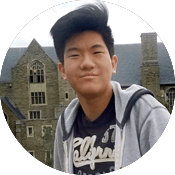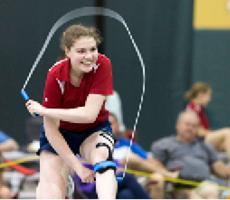- August 22, 2017
- By Lauren Brown
Entrepreneurs and innovators. Volunteers in local schools and for national nonprofits. Artists, athletes and academic successes. Plus, a national jump rope champ and a teen who can solve a Rubik’s Cube in 10 seconds—one-handed.
More than 4,000 bold, creative and ambitious new students arrive in the next week as the next generation of Terps.
They come from the largest applicant pool ever at UMD, another signal that the university’s students are more talented and diverse than ever.
Here, you can meet a few of our newest freshmen and transfer students:

Faraz Burni says his success began with a tragedy: the death of his father following a brain hemorrhage when he was 4. Determined to make his mother proud and happy again, he and his five siblings in Karachi, Pakistan, committed to their education.
“Despite all the hardships, my mother sent all her children to school and never let us work,” he says.
The family emigrated to the U.S. in 2014, and Burni went on to graduate from Montgomery College with a degree in chemical engineering. Now with a research internship at the National Institutes for Standards and Technology under his belt, he comes to Maryland on a full scholarship and with aspirations to become a physician and scientist.

Ethan Cheng believes every child should be able to smile. Born with a cleft lip, he founded the Cleft Support Club at his Montgomery County high school to raise awareness and money for children in developing countries who need the surgery to repair the birth defect, which can cause speech, dental and eating problems.
A biological sciences major in the Honors College, Cheng had his first surgery at age 3 months, and says it’s important that all children with cleft lips or palates have that opportunity: “It’s a simple surgery, but it can really change people’s lives.”

Jeneva Chester
When Jeneva Chester was a young girl struggling with her weight, she wished she had a mentor to teach and celebrate fitness and healthy eating. So she became that mentor to children in her community.
Chester, a psychology major, and three classmates in the International Baccalaureate program at Parkdale High School in Prince George’s County started EduKids Health. Every week for two years, they visited local day cares and elementary schools and led the youngsters in relay races, games focused on the food groups and chats on eating habits.
The recipient of a full scholarship through the Incentive Awards Program, she hopes to find new opportunities to do good at the University of Maryland
“I wanted to come to Maryland because I feel I can do more outreach here, on a big campus where everybody gets involved,” she says.

It’s not a big leap for Christina Kratzmeier to come to Maryland. A math and biochemistry major in the University Honors program from Howard County, she’s been a national jump-rope competitor for nearly a decade.
She’s shown off her skill and agility as an individual and on double-dutch teams every year at the Junior Olympic Games and USA Jump Rope National Championships, winning a pile of gold medals. In addition, Kratzmeier has performed at countless shows, including health fairs, community events, the 2013 and 2015 Macy’s Thanksgiving Day parades, and even college basketball halftime shows for eight years—including at the University of Maryland.
“I know everyone probably says this, but Maryland just always felt right to me, and I’m so happy to spend the next four years here.”

As a high school junior, Amina Lampkin moved to D.C. to live with 29 other students and get a crash course in national politics as a U.S. Senate page, representing U.S. Sen. Chris Murphy of Connecticut. Lampkin learned how the government works (and why it sometimes works so slowly), how people live in other parts of the country and that she’s interested in a writing career, perhaps as a speechwriter or journalist—inspiring her to come to UMD to major in journalism.
Waking up at 5 a.m. to fit in classes before Senate sessions and working on administrative tasks was taxing, but Lampkin says it was worth it: “I made lifelong friends.”

Diagramming her first Punnett squares back in seventh grade, Morgan Robinson got hooked on molecular genetics. “Little did I know that as the most basic form of learning genetics out there.” In high school, Robinson and a team of classmates collaborated with Rutgers and Johns Hopkins University researchers in a study on the viability of landoltia punctata, a type of duckweed, as a source of ethanol. The team isolated messengerRNA from the plant and analyzed its DNA sequence, and its findings were published in the National Center for Biotechnology Information database. At Maryland, Robinson will participate in the Gemstone Honors program and was attracted to the university by its biological sciences major; she’ll specialize in cell biology and genetics.

Six years after being admitted to UMD, Dusan Stojanovic is arriving on campus with an unusual story about the detour.
He immigrated with his mother and sister to Maryland from Serbia in 2009 then graduated from Walt Whitman High, but held off on college to work at a local seafood delivery company. “I just pushed myself to learn as much as I could to learn about running a business.”
When the owner retired and closed shop, Stojanovic opened his own version of the company, D&J Pure Seafood, and scooped up as many of the clients as he could, working 15 to 16 hours a day. He soon realized he wanted to do something that “would touch many people’s lives.” He has a knack for numbers and for saving money, and voila, he sold the business and enrolled at Montgomery College to pursue a degree in finance.
So Stojanovic is headed to College Park after all. “I’m the type of person, once I make up my mind, I don’t give up. This was going to happen.”

Arush Shah is making it a lot easier to medicate safely. He and two friends developed an automated pill dispenser that, in conjunction with an app, dispenses the correct type and amount of oral medications at the right time, preventing deadly errors caused by improper medicine usage.
The team won the 2016 Yale Science and Engineering Award and continues refining its prototype to make it smaller, more sturdy and versatile. That is, when Shah isn’t pursuing his studies in Maryland in computer engineering and cybersecurity—the next form of safety he plans to tackle.

Madison Silver has united tennis great Chris Evert, rapper and entertainer Vanilla Ice and former NFL player Jason Taylor in support of one cause: curing ALS. In 2010, Silver’s aunt, Marjie Berman Block, was diagnosed with the neurological disease; since then, Silver and her family have raised more than $130,000 to research a cure for the disease through several projects, including a call for “slam videos,” in which Evert has power-hit a tennis ball, Vanilla Ice has sledgehammered an ice sculpture and Taylor has slammed a football to the ground, all while donating to the cause and challenging others to do the same.
“I hope that we can get more people from Maryland involved,” says Silver, who plans to major in communication.

Alana Tillery grew more than her leadership skills when she formed a horticulture club at her southern Virginia high school.
Inspired by an article on the engineering challenge of using hydroponic skyscrapers in food deserts, the incoming bioengineering and pre-med major decided to try the technology at school. She rallied her peers to secure donations of two aerogarden units, which require no soil, to grow tomatoes, cucumbers, lettuce and herbs indoors year-round. Classmates and faculty at the urban school, which wasn’t close to grocery stores, scooped up the free produce.
“It takes up to 90 days to harvest the vegetables, and you’re constantly adding water and buying fertilizer and not seeing anything in the growth pods,” she recalls. “And then suddenly you see that sprout.”

In the time it takes most of us to put on our pants, Pavan Ravindra can solve a Rubik’s Cube. One-handed.
Ravindra, who plans to double major in biological sciences and computer science while participating in the Honors College, last year held the national title in this niche competition. He unscrambled the device five times at an average 11 seconds, with a top speed of 9.26 seconds.
He insists it’s more efficient to use just his left hand, saying his movements are so fast that keeping the right hand out of the way can help shave up to a second off his “solve time.”
Ravinindra solved his first Rubik’s Cube in fourth grade, then put it aside for five years until he met a classmate who could do it in 15 seconds. That teen showed him a few tricks, and by the end of the school year, Ravindra could beat him.
But the secret to his speed and dexterity is no trick it all: “It just means three hours a day of practice.”

Ryan Utz’s FIRST robotics team, “RM’d and Dangerous,” was more kind than deadly.
Utz, whose family hosted a Spanish foreign exchange student before junior year, often talked enthusiastically about his adventures with his team at Richard Montgomery High in Montgomery County. His houseguest was both enamored and jealous, explaining that schools in his home country don’t offer such extracurriculars. So Utz organized a “STEM-inar” over the summer, welcoming 10 students visiting from France, Spain and Colombia to a day of learning from peers about programming, electronics, mechanics and fabrication. “It was really exciting to organize and perform,” he says.
Now at Maryland as a mechanical engineering major and Banneker/Key scholar in the Honors College’s Gemstone program, does he want to pursue more work in robotics? Affirmative.
Writer Sala Levin ’10 contributed to this story.
